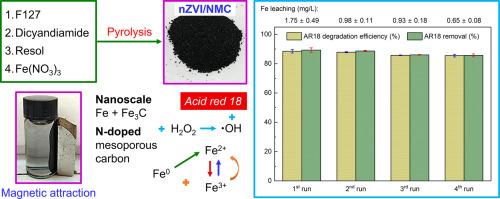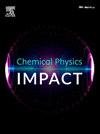Well-dispersed zero-valent iron nanoparticles within nitrogen-doped mesoporous carbon: One-pot synthesis, characterization, and catalytic activity for acid red 18 treatment
IF 4.3
Q2 CHEMISTRY, PHYSICAL
引用次数: 0
Abstract
The current research suggests an innovative approach to synthesize zero-valent iron nanoparticles (nZVI) embedded within nitrogen-doped mesoporous carbon (NMC) by pyrolyzing a mixture containing F127 as a soft template, Fe(NO3)3 as an iron precursor, resol as a carbon source, and dicyandiamide as a nitrogen source. The resulting material (nZVI/NMC) exhibited a well-defined mesostructure with a large mesopore size of 7.6 nm, a high specific surface area of 361 m2/g, and a large total pore volume of 0.41 cm3/g. In addition, nZVI with an average diameter of 17 ± 3 nm was evenly distributed within the NMC framework. With 16.3 wt% Fe loading, nZVI/NMC possessed a strong saturation magnetization of 25.4 emu/g, enabling rapid magnetic separation. Subsequently, nZVI/NMC was investigated as a catalyst for acid red 18 (AR18) treatment by H2O2. At pH 3.0 and 200 mg/L H2O2, 1.00 g/L nZVI/NMC completely removed 50 mg/L AR18 within 30 min. Moreover, the catalyst maintained excellent reusability with negligible iron leaching over four successive runs. With its high catalytic activity, stability, and facile magnetic recoverability, nZVI/NMC demonstrates significant promise as a rapid and reusable catalyst for treatment of organic pollutants in wastewater.

氮掺杂介孔碳中分散良好的零价铁纳米颗粒:一锅合成、表征和酸性红18处理的催化活性
本研究提出了一种以F127为软模板,Fe(NO3)3为铁前驱体,溶胶为碳源,双氰胺为氮源的混合物热解合成嵌入氮掺杂介孔碳(NMC)内的零价铁纳米颗粒(nZVI)的创新方法。所得材料(nZVI/NMC)具有良好的介孔结构,介孔尺寸为7.6 nm,比表面积为361 m2/g,总孔体积为0.41 cm3/g。此外,平均直径为17±3 nm的nZVI均匀分布在NMC框架内。当铁含量为16.3 wt%时,nZVI/NMC具有25.4 emu/g的强饱和磁化强度,能够实现快速磁分离。随后,研究了nZVI/NMC作为H2O2处理酸性红18 (AR18)的催化剂。在pH 3.0和H2O2浓度为200 mg/L的条件下,1.00 g/L的nZVI/NMC在30 min内完全去除50 mg/L的AR18。此外,该催化剂在连续四次运行中保持了良好的可重复使用性,铁浸出可以忽略不计。nZVI/NMC具有高催化活性、稳定性和易磁回收性,是一种快速、可重复使用的废水有机污染物处理催化剂。
本文章由计算机程序翻译,如有差异,请以英文原文为准。
求助全文
约1分钟内获得全文
求助全文
来源期刊

Chemical Physics Impact
Materials Science-Materials Science (miscellaneous)
CiteScore
2.60
自引率
0.00%
发文量
65
审稿时长
46 days
 求助内容:
求助内容: 应助结果提醒方式:
应助结果提醒方式:


